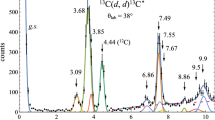Abstract
The systematics of photon absorption cross sections in nuclei and small metal particles are examined as a function of the number of constituent fermionsA. It is pointed out that the shell-structure-linked oscillations in the full width at half maximum (FWHM) of the photoneutron cross section in nuclei, earlier recognized forA>63, in fact persist down to the lightest nuclei. Averaging over the oscillations or focusing on the lower envelope of the oscillating curve (magic nuclei), the FWHM is seen to generally decrease with increasingA, consistent withA −1/3, a dependence which was earlier known to hold in metal particle systems. If the FWHMs are scaled by the respective Fermi energies and the inverse radii by the Fermi wave vectors, the two data sets become comparable in magnitude. A schematic theoretical description of the systematics is presented.
Similar content being viewed by others
References
S Sugano, inMicroclusters edited by S Sugano, Y Nishina and S Ohnishi (Springer Berlin, 1987)
W A de Heer, W D Knight, M Y Chou and M L Cohen,Solid state physics 40, 93 (1987)
B L Berman and S C Fultz,Rev. Mod. Phys. 47, 713 (1975)
A van der Woude,Prog. Part. Nucl. Phys. 18, 217 (1987)
M Born and E Wolf,Principles of optics (Pergamon, Oxford, 1970) ch. 13
S P Apell, J Giraldo and S Lundqvist,Phase Transitions 24–26, 577 (1990)
V V Kresin,Phys. Rep. 220, 1 (1992)
M Barma and R S Bhalerao, inPhysics and chemistry of finite systems: from clusters to crystals edited by P Jena, S N Khanna and B K Rao (Kluwer, Dordrecht, 1992) NATO ASI Sr.Vol II, p. 881
S S Dietrich and B L Berman,At. Data Nucl. Data Tables 38, 199 (1988)
R Bergère, inPhotonuclear reactions edited by S Costa and C Schaerf, Lecture Notes in Physics (Springer, Berlin, 1977)61, 114
K A Snover,Ann. Rev. Nucl. Part. Sci. 36, 545 (1986)
Although28Si is not a magic nucleus, it displays behaviour similar to a magic nucleus in at least one other context: the plot of nuclear electric quadrupole moment vsZ orN passes through a zero near28Si, indicating a prolate to oblate transition. Similar transitions also occur at the magic numbers [13].
M A Preston and R K Bhaduri,Structure of the nucleus (Addison-Wesley, Reading, 1975 figs. 3.2 and 10.12 pages 73 and 470
U Kreibig and L Genzel,Surf. Sci. 156, 678 (1985)
K Selby, M Vollmer, J Masui, W A de Heer and W D Knight,Phys. Rev. B40, 5417 (1989)
K Selby, V Kresin, J Masui, M Vollmer, A Scheidemann and W D Knight,Z. Phys. D19, 43 (1991)
J Tiggesbäumker, L Köller, H O Lutz and K H Meiwes-Broer,Chem. Phys. Lett. 190, 42
W D Myers, W J Swiatecki, T Kodama, L J El-Jaick and E R Hilf,Phys. Rev. C15, 2032 (1977)
K P Charlé, W Schulze and B WinterZ. Phys. D12, 471 (1989)
N W Ashcroft and N D Mermin,Solid state physics (Holt, Rinehart and Winston, New York, 1976) ch. 1
M Goldhaber and E Teller,Phys. Rev. 74, 1046 (1948)
H Steinwedel and J H D Jensen,Z. Naturforschung 5a, 413 (1950)
U Kreibig,J. Phys. F4, 999 (1974)
A Kawabata and R Kubo,J. Phys. Soc. Jpn. 21, 1765 (1966)
M Barma and V Subrahmanyam,J. Phys. Cond. Matter 1, 7681 (1989)
C Yannouleas and R Broglia,Ann. Phys. (NY) 217, 105 (1992)
D M Brink,Nucl. Phys. 4, 215 (1957)
J Blocki, Y Boneh, J R Nix, J Randrup, M Robel, A J Sierk and W J Swiatecki,Ann. Phys. (NY) 113, 330 (1978)
C Yannouleas,Nucl. Phys. A439, 336 (1985)
J Wambach,Rep. Prog. Phys. 51, 989 (1988)
For real nuclei, the full two-body contribution Γ↓ may differ significantly from Γ ↓∞ .
K Okamoto,Phys. Rev. 110, 143 (1958)
This is in contrast to the statements made in various reviews [34–37] that the width, likeω 0, varies smoothly withA.
J Speth and A van der Woude,Rep. Prog. Phys. 44, 719 (1981)
K Goeke and J Speth,Ann. Rev. Nucl. Part. Sci. 32, 65 (1982)
M N Harakesh, contribution toXVII Summer School on nuclear structure by means of nuclear reactions, Mikolajki, Polland 1985 (unpublished)
A van der Woude, inelectric and magnetic giant resonances in nuclei edited by J Speth (World Scientific, Singapore, 1991 100
Author information
Authors and Affiliations
Corresponding author
Rights and permissions
About this article
Cite this article
Bhalerao, R.S., Barma, M. Collective dipole oscillations in atomic nuclei and small metal particles. Pramana - J Phys 40, 311–320 (1993). https://doi.org/10.1007/BF02845850
Received:
Issue Date:
DOI: https://doi.org/10.1007/BF02845850




